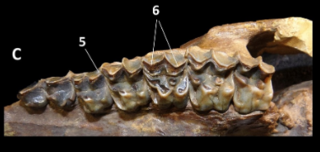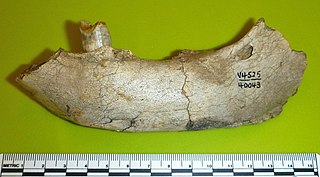
Hapalops is an extinct genus of ground sloth from the Early to Late Miocene of Brazil, Bolivia, Colombia, and Argentina in South America.

Theosodon is an extinct genus of litoptern mammal from the Early to Middle Miocene of South America.

Xenorhinotherium is an extinct genus of macraucheniine macraucheniids, closely related to Macrauchenia of Patagonia. The type species is X. bahiense.

Proterotheriidae is an extinct family of litoptern ungulates known from the Oligocene-Late Pleistocene of South America. Members of the group were small-medium sized cursorial herbivores with brachydont teeth, with their toes showing progressive reduction, with later members of the group bearing weight on a single large toe similar to living horses.

Miocochilius is an extinct genus of small notoungulate mammals (typotheres) native to South America. The genus lived during the Middle Miocene epoch. The genus contains two described species, the type species M. anomopodus described in 1953 by Ruben Arthur Stirton and M. federicoi, described and included in the genus by Darin A. Croft.
Cullinia is an extinct genus of litoptern, an order of South American native ungulates that included horse-like and camel-like animals such as Macrauchenia. It is only known from fragmentary remains. Cullinia levis is known from Chasicoan remains found in the Arroyo Chasicó Formation of Argentina, and remains from the Brazilian state of Acre and the Huayquerian Ituzaingó Formation have been assigned to Cullinia sp..
Proterotherium is an extinct genus of litoptern mammal of the family Proterotheriidae that lived during the Late Miocene of Argentina and Chile. Fossils of this genus have been found in the Ituzaingó Formation of Argentina, and the Galera Formation of Chile.
Promacrauchenia is an extinct genus of macraucheniids that lived during the Late Miocene to Late Pliocene epochs of what is now Argentina and Bolivia. It belongs to the subfamily Macraucheniinae, which also includes Huayqueriana, Macrauchenia, and Xenorhinotherium. Fossils of this genus have been found in the Ituzaingó, Andalhuala, and Cerro Azul Formations of Argentina.
Llullataruca is an extinct genus of macraucheniid litoptern. It lived during the Middle Miocene of what is now Bolivia.
Megadolodus is an extinct genus of proterotheriid litopterns.
Mesolicaphrium is a genus of extinct litoptern from the late middle Miocene of southern Colombia. It was named in 2020 by Andrew McGrath and colleagues, for the species previously classified as Prolicaphrium sanalfonensis from the La Victoria and Villavieja Formations of the Honda Group, Colombia. The type species is M. sanalfonense, known from the jaw symphysis and two right mandibular rami, and teeth. Mesolicaphrium is derived from the similarity to the names Prolicaphrium and Neolicaphrium, and being in between both taxa in age. The taxon was recovered in a phylogenetic analysis as the sister taxon of Diplasiotherium, closely related to Olisanophus.
Neodolodus is a genus of extinct litoptern from the late middle Miocene of southern Colombia. It was named in 1986 by Hoffstetter and Soria, for the species Neodolodus colombianus from the Castilletes Formation and the La Victoria and Villavieja Formations of the Honda Group. The type species N. colombianus is known from a right mandibular ramus, teeth, and part of the fore- and hindlimbs. Neodolodus has been classified as a species of Prothoatherium or Lambdaconus, but was recognized as a distinct genus by McGrath and colleagues in 2020. The taxon was recovered in a phylogenetic analysis as the sister taxon of Protheosodon, between other proterotheriid genera like Picturotherium and Anisolophus.
Uruguayodon is an extinct genus of proterotheriid from the middle Pleistocene of Uruguay. It is known from the type and only species U. alius, named by Corona and colleagues in 2019 for dentaries and a partial postcrania from the Raigón Formation. Uruguayodon represents one of the latest occurrences of Proterotheriidae, with only Neolicaphrium representing other remains from the Pleistocene to possibly Holocene.
Prolicaphrium is an extinct genus of proterotheriid litoptern that lived during the Early Miocene, in what is now Argentina. Fossils have been found in the Sarmiento Formation of Argentina.

Tetramerorhinus is an extinct genus of proterotheriid litoptern that lived during the Early and Middle Miocene in what is now Argentina and Peru.

Paramacrauchenia is an extinct genus of proterotheriid litopterns from the Early Miocene of what is now Argentina and Chile. Its fossils have been found in the Sarmiento and Santa Cruz Formations of Argentina and Chile.
Villarroelia is an extinct genus of proterotheriid from the Middle Miocene of Colombia.

Magdalenabradys is an extinct genus of mylodontid ground sloths that lived during the Middle Miocene and Early Pliocene of what is now Colombia and Venezuela. Fossils have been found in the Villavieja Formation of the Honda Group in Colombia, and the Codore and Urumaco Formations of Venezuela.
Pternoconius is an extinct genus of macraucheniid litoptern from the Late Oligocene and Early Miocene of Argentina. Fossils of this genus have been found in the Sarmiento Formation of Argentina.
Guilielmofloweria is an extinct genus of proterotheriid litoptern that lived from the Middle to Late Eocene of what is now Argentina. Fossils have been found in the Sarmiento Formation of Argentina.
















